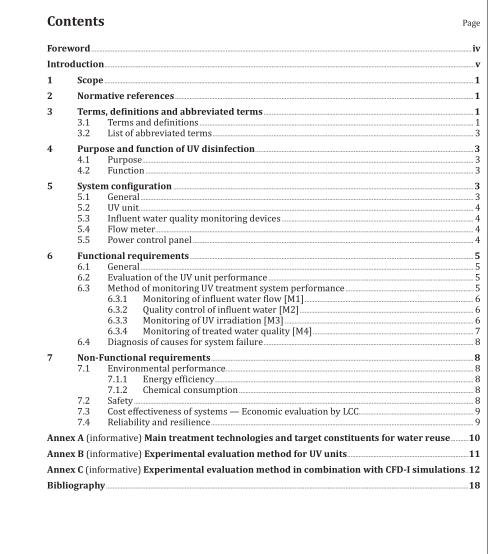ISO 20468-4:2021 pdf download.Guidelines for performance evaluation of treatment technologies for water reuse systems — Part 4: UV Disinfection.
5.2 UV unit A UV unit has simple components including irradiation chamber, a light source, an automatic cleaning system and a UV intensity sensor. A specific UV unit may need one or more UV intensity sensor and one or more irradiation chamber and light source, depending on the specifics of the application. UV units may be categorized into closed and open systems, based on the configuration of UV units in the irradiation chamber.
The closed system has a UV unit, comprised of UV lamps and their sleeves, placed in the closed vessel flow chamber. Meanwhile, the open system has a UV unit immersed in an open channel or chamber with gravity flow and water level control device. UV systems can also consist of non-contact unit designs with UV lamps suspended outside a transparent conduit that carries the wastewater.
— light source A light source for UV disinfection should have a germicidal emission at wavelengths appropriate to the task, often at the wavelength of 253,7 nm or a combination of wavelengths between 200-385 nm. Options include low-pressure mercury lamps, medium-pressure mercury lamps, excimer lamps, pulsed-Xenon lamps, and ultraviolet light emitting diodes. The light source should be housed in a lamp protection component.
— cleaning system A cleaning system is the device having a wiper driven by electric power supply, hydraulic power supply or pressurized air, or ultrasonic wave, etc. Options include a mechanical wiper consisting of a brush, ring or a mechanical chemical wiper consisting of a chamber with rings filled with a washing liquid.
— UV intensity sensor A UV intensity sensor is installed to measure the UV irradiance in the irradiation chamber so that the irradiance can be tracked and it can be determined whether the required dose has been provided.
— ballast A ballast is installed when using a UV lamp as a light source. Ballasts provide the power that the lamp converts to UV photons (energy).
5.3 Influent water quality monitoring devices A UV transmittance monitor can be used to feed data to the system controller to adjust the power of the lamp to assure that the required dose is provided. To check whether or not the water quality of the influent has changed from the design conditions, water quality monitors including a UV transmittance monitor, a turbidity meter (optional) etc. are used.
5.4 Flow meter Generally, each UV unit should have a dedicated flow meter for several reasons, including to confirm that the unit is operating within the validated flow rate range. The measured flow rate data may be sent to control panel and may be utilized for light-source controlling, monitoring and operating in order to achieve system performance. The method of flow rate measurement should be selected according to the variability in plant flow rate and installation conditions.
5.5 Power control panel
The control panel has the following functions: power receiving, power supplying, controlling, monitoring and operating, and other functions for the light source and other apparatuses.
6 Functional requirements
6.1 General
Functional requirements for treatment technologies address the transformation of influent water quality constituents to produce reclaimed water and include both water quality and water quantity parameters. One of the functional requirements of a given UV treatment system is to secure, at all times, enough UV dose to obtain a target quality of the reclaimed water that is appropriate for application of such water. The UV dose is the time integral of the fluence rate or irradiance. What is necessary to this end includes: use of a UV light source with appropriate irradiance; and retaining the reclaimed water in a UV irradiation chamber for a predetermined time period. In actual equipment, the irradiation time and UV irradiance in the UV irradiation chamber vary from one portion to another due to the shape of the chamber, as well as the location and number of the light sources, and other similar factors. Water quality determined by, for example, suspended matter and UV absorbing components also reduces UV transmittance, and thereby affects UV dose distribution.
By taking these influences into consideration, a predetermined UV dose, or higher dose that is sufficient for the water flow passing through the UV irradiation chamber, shall be secured at all times. Methods for evaluating the performance of the UV unit in the design stage and for subsequently monitoring the performance of the UV disinfection system in operation are provided below.ISO 20468-4 pdf download.ISO 20468-4 pdf download
